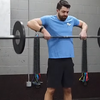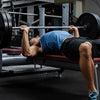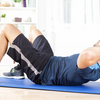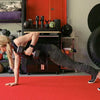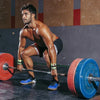How To Do the Barbell Snatch-Form, Muscles Worked and Variations
Your strength training routine is incomplete without a barbell snatch. The snatch is highly demanding, impressive, and difficult to master. No wonder bodybuilders dedicate a huge part of their training career to perfecting this exercise. But with the right guidance, you can also incorporate this into your workout schedule in no time. This article will discuss the proper technique for doing the barbell snatch, the muscles used, the benefits, and more.
What is the Barbell Snatch?
The snatch is one of two main lifts in Olympic weightlifting. It's an advanced weightlifting technique where you lift a weighted barbell off the floor and use your hips to get the bar above your head, simultaneously squatting beneath it.
Executing a perfect snatch requires good timing, strength, adequate speed, and skill. The beauty of the snatch lift is that it works most of the muscles, from the trapezius to your glutes. Both weightlifters and athletes from other sports perform it to improve coordination, strength, speed, flexibility, power, and mobility.
How To Do A Snatch – Phases And Snatch Technique
1. Starting Position
Approach the barbell with a shoulder-width stance and position the sport barbell over your toes' phalanges. Use a wide snatch grip, key to proper Olympic snatch form. Keep the barbell close to your shins to maintain a straight bar path. Open the chest, arch the back, and brace the core. Arms should be relaxed and extended. Keep shoulders over the bar and push the knees out in line with the toes—this sets up a strong, efficient snatch starting position.
2. First Pull
In this phase of the barbell snatch, the lifter pulls the barbell bar from the floor to the mid-thigh position. During the first pull, the focus is on generating explosive power and maintaining proper snatch form. This involves keeping the back straight, driving through the legs, and utilizing the hips and lower body to initiate the upward movement of the Olympic barbell.
The first pull sets the foundation for a successful Olympic snatch lift by establishing momentum and positioning for the subsequent phases. It's important to maintain the center of gravity over the middle of the foot, keep the shoulders over the bar, and ensure the arms remain relaxed.
3. Second Pull
The 2nd Pull begins after completing the first pull in the barbell snatch and continues until the lifter achieves full extension through the ankles, knees, and hips. This explosive movement generates maximum vertical force and barbell acceleration, crucial for executing a powerful and efficient snatch weightlifting. At the end of the 2nd pull, the heels will leave the platform, the lifters body will be fully extended, and the barbell should now begin to travel up with an almost vertical trajectory.
4. Power Position
At the moment the barbell reaches the power position (in the groin), straighten the knees and hips powerfully and direct the elbows upwards. The main goal of this stage is to pass a vertical explosive impulse from the body to the weight barbell. This phase is crucial for proper barbell snatch technique, maximizing explosive strength, and maintaining correct Olympic weightlifting form.
5. Turnover
In this phase of the barbell snatch technique, the lifter transitions the barbell from its upward trajectory into the overhead snatch position. This involves quickly rotating the wrists and elbows under the bar while maintaining a strong, stable core.
The lifter needs to be fast and precise to ensure the barbell moves smoothly into the receiving position without losing balance or control. The goal of this phase is to effectively "turn over" the gym barbell and prepare to catch it securely overhead with proper Olympic weightlifting form.
6. Receive the Bar Overhead
The goal of this phase is to stabilize the center of gravity and maintain balance. Keep the back muscles engaged, shoulders stable, and elbows locked to safely catch the barbell overhead. This is a critical moment in the snatch workout, where proper form ensures overhead strength and injury prevention.
7. Recovery
Never rush to stand up during the barbell snatch recovery phase. Whether in training or Olympic weightlifting competition, an athlete must be confident they fully control both the barbell overhead and every part of their body. Even elite lifters have missed successful lifts and lost medals by rushing the final part of the snatch technique. Practice good snatch habits: patience and endurance are essential at this stage.
Benefits of the Barbell Snatch
Strength And Power Generation Improvement
We can train explosive strength and power by doing "right" strength exercises at a rapid pace. Snatch in weightlifting is exactly this kind of exercise so you can significantly improve your power with its help. Additionally, such a boost makes you run faster and jump higher. Another great benefit of snatch is that it involves mainly hip work which is crucial for jumping and running.
Improves Flexibility And Mobility
To perform the Olympic weightlifting snatch correctly, you need to have good flexibility and mobility in your joints. By practicing this exercise, you can improve your range of motion and flexibility, which can help prevent injuries and improve your athletic performance.
Improved Balance and Posture
A good snatch form can help you get a better posture, resulting in a tighter core, retracted shoulders, straightened back, and a lesser painful back. The catch in the overhead snatch requires a high amount of balance. Repetitive snatch and lift will help you achieve balance and overhead strength like no other exercise.
Enhanced Core Stability
The core is more than just for looks; it contains muscles that work together to support your body's motion. The snatch is a unique exercise that requires good core stability in the catch position. Being able to do the snatch properly will fulfill the potential your core beholds.
Increases Calorie Burn
The Olympic snatch is a highly intense exercise that can burn a significant amount of calories. By incorporating this exercise into your workout routine, you can increase your calorie burn and help with weight loss and management.
Barbell Snatch Muscles Worked
The barbell snatch is quite a unique arm lift exercise as it trains various muscles. Here are some muscles that work the hardest during the snatch.
Quadriceps
These are the muscles in front of your thigh. The quads help keep the knees stable, flex the hips, and maintain balance and posture. In addition, the work done by the Quads is essential to lift the barbell as it is the main muscle used in the squat part of the exercise.
Deltoids
These are the muscles on the top of your shoulders. The deltoids allow for easy arm movement and insulate the shoulder joint. They play an important role in balancing the bar and making sure to offer the necessary upper body strength for this workout.
Trapezius
This is the diamond-shaped, large muscle found on the back. It starts from where your skull ends and goes halfway down your back. The trapezius muscles help in better mobility in your arms, neck, and head, as well as help stabilize the spine.
Glutes
These are the 3 muscles that are present inside your buttocks. The main function of the glutes in the snatch is to be able to rotate and extend the hip and thigh. Therefore, the glutes are worked for almost the entirety of the snatch. It is no surprise as most of the strength training exercises involve extensive use of the glutes.
Barbell Snatch Variations
The renowned snatch has many kinds of variations. It does not limit the lifters to one kind of movement chain. The most common ones include:
Barbell Power Snatch
The barbell power snatch has a similar starting position. You are in a deep squat with a wide grip, and your knees are ahead of the bar. The key difference in the power snatch is that as you pull the bar off with your legs and reach above your hips, you use your elbows to bring it to the highest position. Once you feel the bar has peaked, rapidly drop below it to get an overhead catch, and then it follows the standard method.
Barbell Hang Snatch
In the barbell hang snatch, once you pull the weight to your hips, fold in your knees a little. In a rapid Then, lift the bar and come underneath it simultaneously, moving into the deep squat position. This shortens the total time, and the muscles work less for the snatch.
Snatch Grip Barbell Shrugs
The snatch grip barbell shrug is quite different from the regular barbell snap. It mainly focuses on the shoulder muscles. The starting is the same as the regular snatch, where you grip the barbell with a wide gap. Similarly, you pull up the bar by applying pressure on your feet. Once you have the barbell next to the hips, lock out your arms and shrug your shoulders up to your ears.
Barbell Snatch Grip Deadlift
The snatch grip deadlift starts with a similar wide grip to the regular snatch. Then it transitions into more of a deadlift. Keep your arms locked in the wide grip as you lift the bar up. As you bring the bar towards your hips, push the bar out with your legs. Make sure that the bar stays close to your center of gravity as you bring up the bar. This variation will help you activate more of your back muscles and glutes.
Barbell Snatch Safety and Precautions
The barbell is an advanced weightlifting technique, and not everyone can go out and try it without supervision. So, you must take care of the following things before you try them out.
- It is recommended that people having back issues should not try the snatch as this exercise puts a large amount of strain on your lower back.
- Ensure you get a good warm-up before you attempt the snatch, as it will put a lot of stress on most of your muscles simultaneously.
- You must always carry out basic gym precautions like using straps, pins, and belts. These make workouts easier through added support and comfort.
Why Should We Use Straps In Snatch Training?
Using straps in Olympic snatch training can be beneficial for some lifters in certain situations. Here are some reasons why lifters may choose to use straps:
- To Improve Grip Strength: While the hook grip is an effective grip technique, some lifters may find that they still have trouble holding onto the barbell during heavy lifting. Using straps can help these lifters maintain a secure grip on the barbell, allowing them to focus on developing power and explosiveness in their lifts.
- To Reduce Fatigue: Snatch lifting can be very demanding on the hands, and some lifters may find that their grip strength starts to give out before their other muscles. Using straps can help reduce the amount of fatigue on the hands, allowing the lifter to focus on developing other areas of their technique.
- To Target Specific Muscle Groups: Using straps can allow the lifter to focus more on specific muscle groups, such as the shoulders or legs, by reducing the amount of grip strength needed during the lift. This can be useful for lifters who are recovering from an injury or who have specific areas they want to target in their training.
- To Practice Technique: In some cases, using straps can help lifters practice their technique more effectively. For example, if a lifter is having trouble with their grip during the snatch, using straps can allow them to focus on other areas of their technique without worrying about their grip strength.
Conclusion
The snatch exercise is a highly effective and advanced weightlifting technique that will help you boost your core strength as well as work on all kinds of muscles. The more you practice, the better you will get at it and make it feel effortless.
It is a great feat to conquer and add to your workout routine as it can fulfill that gap you might feel in your routine. This article has everything you might need to know about the barbell snatch and get it right. Now all that's left for you to do is to do your best!








